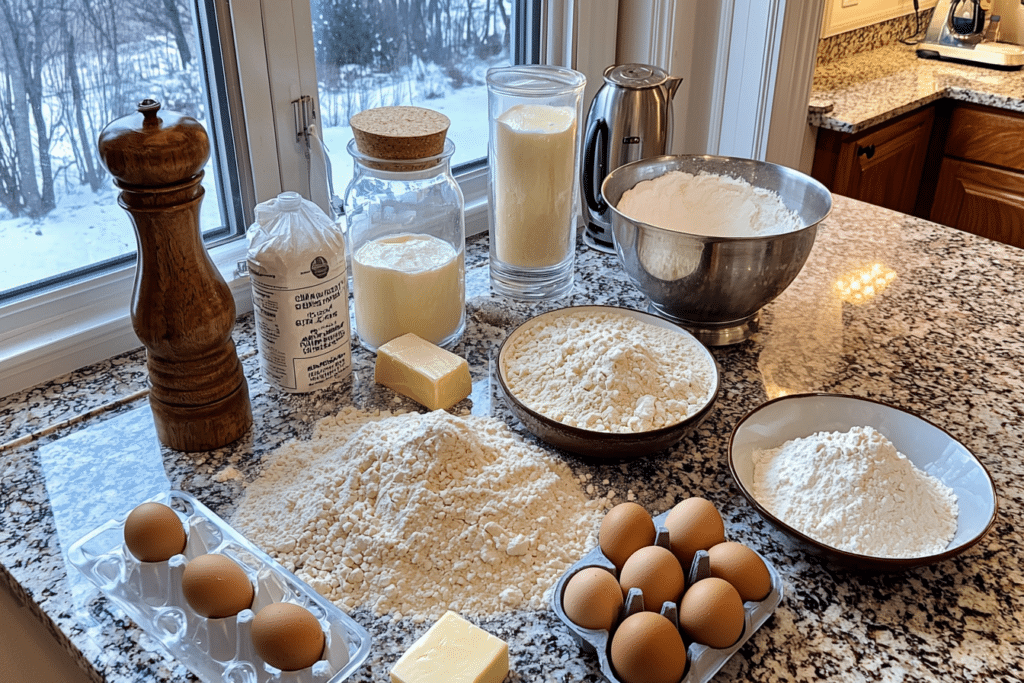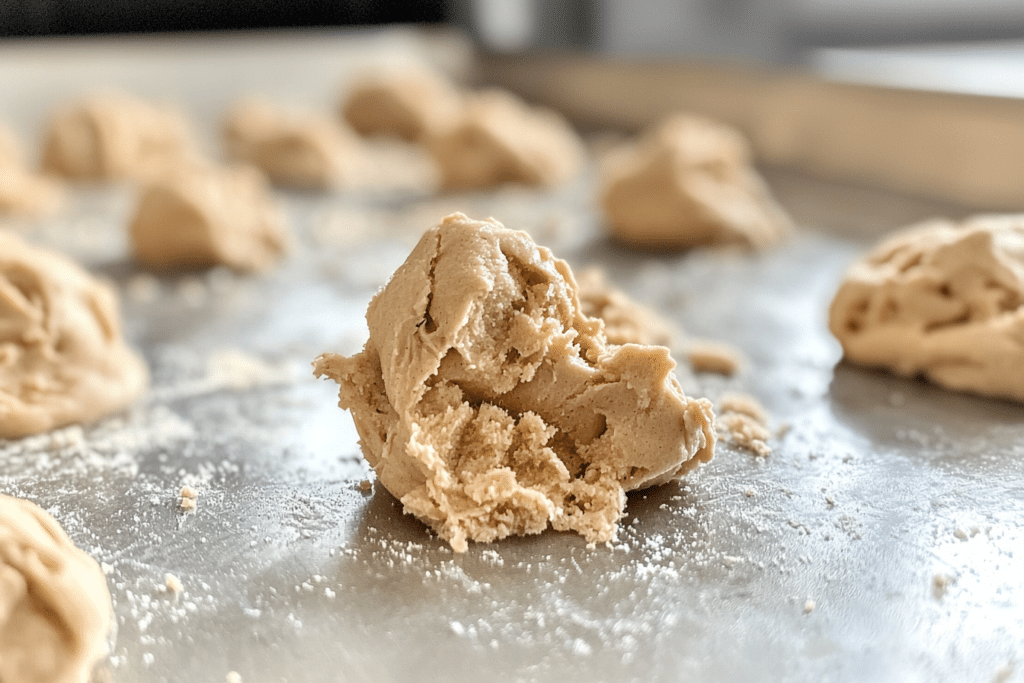1. Introduction
Cookies are one of the most beloved baked goods worldwide. But what’s the secret to soft chewy cookies? While crispy cookies have their fans, soft, chewy ones are unmatched in their melt-in-your-mouth appeal. This guide will reveal the best tips and techniques to help you achieve perfectly soft cookies every time.
What makes cookies soft and chewy? This article will explore the science behind cookie texture, share proven tips and tricks, and answer common questions about making soft and chewy cookies. Whether you’re a seasoned baker or a beginner, this guide will help you bake cookies that everyone will love.
2. The Science Behind The Secret to Soft and Chewy Cookies
Baking cookies is as much about understanding science as it is about following a recipe. Each ingredient and technique plays a specific role in creating the soft and chewy texture we all crave. Understanding the science behind cookie texture is key to mastering the secret to soft chewy cookies. Learn more about the science of baking cookies. Let’s delve into the science of cookie perfection.
2.1 Understanding the role of ingredients is essential to unlocking the secret to soft chewy cookies

The ingredients you use determine the cookie’s softness, chewiness, and overall structure:
- Butter: Butter not only adds richness but also significantly impacts the texture. Its fat content helps create soft cookies, while its moisture content contributes to chewiness. For best results, use softened butter at room temperature.
- Brown Sugar: This ingredient is essential for chewiness. Brown sugar contains more moisture than granulated sugar, which helps retain softness during baking.
- Eggs: Eggs act as binders and provide moisture, both of which are crucial for creating soft, chewy cookies.
The Nestle chocolate chip cookie recipe is a great example of how ingredient ratios influence the texture of cookies. Check out the recipe here.
2.2 Importance of Ratios and Balance
The balance between wet and dry ingredients determines how cookies bake:
- Sugar Ratios: A higher ratio of brown sugar to granulated sugar increases moisture and softness.
- Flour-to-Fat Ratios: Using too much flour can make cookies dense and cakey, while too little flour leads to spreading.
- Egg-to-Dough Ratios: Using extra egg yolks adds richness and helps retain moisture, while too many eggs can make cookies rubbery.
Pro Tip: Slightly reducing granulated sugar and increasing brown sugar creates a chewier texture without compromising sweetness.
3. Tips and Tricks for Secret to Soft Chewy Cookies
Achieving soft and chewy cookies isn’t just about following a recipe—it’s about using the right techniques to enhance texture and flavor. These tips and tricks will help you bake cookies that are irresistibly soft every time.
3.1 Cornstarch plays a crucial role in achieving the secret to soft chewy cookies by improving their texture
Cornstarch is a secret weapon for creating soft cookies. It helps:
- Add tenderness to the dough without making it crumbly.
- Prevent over-spreading during baking, which helps maintain thickness.
How to Use It: Add 1-2 teaspoons of cornstarch to your dry ingredients. This small amount can make a big difference in texture.
3.2 Chilling the Dough

Refrigerating cookie dough before baking is one of the most effective ways to enhance texture. Chilling:
- Solidifies the fat, reducing spreading during baking.
- Allows flavors to meld, resulting in a more robust taste.
Pro Tip: Chill the dough for at least 30 minutes, but for the best results, refrigerate it overnight.
3.3 Underbaking for Softness
Slightly underbaking your cookies ensures a soft center while the edges are just set. Here’s how:
- Remove cookies from the oven when the edges are golden but the centers appear slightly underdone.
- The residual heat will continue to bake the centers as the cookies cool.
Quick Tip: Use an oven thermometer to ensure accurate temperature for consistent results.
3.4 Using Brown Sugar Over Granulated Sugar
Brown sugar’s moisture content makes it essential for chewy cookies. Compared to granulated sugar:
- Brown sugar creates a denser, moister texture.
- Granulated sugar tends to make cookies spread and crisp up.
Recipe Hack: Replace half or more of the granulated sugar with brown sugar for softer cookies.
3.5 Proper Storage to Retain Softness
Even perfectly baked cookies can lose their softness if not stored properly. Follow these tips:
- Store cookies in an airtight container as soon as they’ve cooled.
- Place a slice of bread or a piece of apple in the container to retain moisture.
- Avoid refrigerating cookies, as this can dry them out.
Learn how to store cookies effectively to retain their softness by exploring this guide on storing baked goods for freshness.
4. Common Mistakes In The Secret to Soft Chewy Cookies and How to Avoid Them
Even experienced bakers can encounter challenges when trying to make soft and chewy cookies. Understanding these common mistakes and how to avoid them is crucial for consistent success. To understand more about why cookies sometimes spread or flatten, visit our guide on why Nestle chocolate chip cookies go flat.
4.1 Overbaking is one mistake that can prevent you from achieving the secret to soft chewy cookies
One of the most frequent causes of hard cookies is overbaking. Even a minute too long in the oven can lead to dryness.
- How to Avoid:
- Check cookies a minute or two before the minimum baking time listed in the recipe.
- Remove cookies when the edges are set and the centers still look slightly underbaked.
- Cool cookies on the baking sheet for a few minutes before transferring them to a rack.
4.2 Skipping the Chilling Step
Chilling dough is essential for achieving soft, thick cookies. Skipping this step often results in spreading and flat cookies.
- Why It Matters: Refrigerating dough solidifies the fats, which slow down spreading during baking.
- How to Fix: Always plan ahead to allow time for chilling—at least 30 minutes or overnight for best results.
4.3 Using Too Much Flour
Excess flour can make cookies dense and dry, which affects their chewiness.
- How to Avoid: Measure flour accurately using the spoon-and-level method. Avoid scooping directly from the bag, as this packs too much flour into the measuring cup.
- Pro Tip: If your dough feels too dry, add a teaspoon of milk or water at a time until the consistency improves.
4.4 Not Measuring Ingredients Properly
Baking is a science, and small inaccuracies can lead to big problems.
- Common Issues: Too much sugar can cause excessive spreading, while too little fat or eggs can make cookies crumbly.
- How to Fix: Use proper measuring tools:
- Dry measuring cups for flour and sugar.
- Liquid measuring cups for ingredients like milk or oil.
- A digital scale for precise measurements, if possible.
5. Creative Variations for The Secret to Soft Chewy Cookies
Once you’ve mastered the basics of making soft and chewy cookies, it’s time to get creative. Adding new ingredients or tweaking the recipe can take your cookies to the next level while still preserving that tender, chewy texture.
5.1 Adding mix-ins enhances flavor without compromising the secret to soft chewy cookies
Enhance your cookies with fun mix-ins that add flavor and texture:
- Nuts: Add a crunch with chopped walnuts, pecans, or almonds.
- Dried Fruits: Incorporate raisins, cranberries, or chopped dates for a chewy, fruity twist.
- Chocolate Variations: Experiment with white chocolate, dark chocolate, or flavored chips like peanut butter or mint.
- Candy and Treats: Try adding toffee bits, marshmallows, or crushed pretzels for a sweet-and-salty combination.
Pro Tip: Keep mix-ins to about 1 cup total to avoid overwhelming the dough.
5.2 Adjusting for Dietary Preferences
Soft cookies can still be enjoyed by those with dietary restrictions. Here’s how to adapt the recipe:
- Vegan Cookies: Use plant-based butter or coconut oil, and replace eggs with flaxseed meal or applesauce.
- Gluten-Free Cookies: Substitute all-purpose flour with a gluten-free flour blend. Adjust the dough consistency as needed since gluten-free flours absorb moisture differently.
- Lower Sugar Options: Replace some sugar with natural sweeteners like maple syrup or coconut sugar to reduce refined sugar content.
Quick Tip: Taste-test as you go when making substitutions to ensure the flavor balance is just right. For tips on making soft and chewy cookies gluten-free, check out this gluten-free baking guide.
5.3 Flavor Enhancements

Boost the flavor of your cookies with small additions:
- Vanilla Extract: Add an extra teaspoon for a richer, deeper flavor.
- Spices: Include cinnamon, nutmeg, or even a pinch of cardamom for a warm, aromatic touch.
- Citrus Zest: Grate orange or lemon zest into the dough for a fresh, tangy flavor.
- Espresso Powder: Add a teaspoon to enhance chocolate flavors without making the cookies taste like coffee.
Pro Tip: Start with small amounts when experimenting with new flavors, and adjust to taste. Pair your cookies with a unique drink like a green tea shot. Learn how to make one with this green tea shot recipe.
6. FAQs About The Secret to Soft Chewy Cookies
6.1 Why Does Brown Sugar Make Cookies Softer?
Brown sugar contains molasses, which adds moisture and helps retain softness in baked cookies.
6.2 How Does Cornstarch Change the Texture?
Cornstarch acts as a tenderizing agent, giving cookies a softer, almost melt-in-your-mouth texture by reducing gluten formation.
6.3 Can I Make Soft Cookies Without Eggs?
Yes, you can replace eggs with flaxseed meal mixed with water, applesauce, or mashed banana. These alternatives bind the dough and provide moisture.
6.4 What’s the Secret to Soft Chewy Cookies?
Store cookies in an airtight container at room temperature. Adding a slice of bread or a piece of apple to the container helps maintain moisture.
6.5 How Do I Know If I’ve Underbaked My Cookies?
Underbaked cookies will have set edges but slightly soft centers. They’ll firm up as they cool while remaining chewy.
6.6 Can I Fix Hard Cookies After Baking?
While you can’t fully restore their texture, you can microwave hard cookies with a damp paper towel for a few seconds to soften them temporarily.
6.7 Why Is Chilling the Dough Important?
Chilling solidifies the fat and reduces spreading, ensuring a thicker and softer cookie. It also allows the flavors to develop further.
6.8 Do High-Altitude Adjustments Affect Cookie Texture?
Yes, at higher altitudes, you may need to add extra flour, reduce sugar slightly, and lower the baking temperature to maintain the desired texture.
6.9 Can I Use Oil Instead of Butter for Soft Cookies?
Yes, but the texture may differ. Oil makes cookies softer but less chewy since it lacks the aerating properties of butter.
6.10 How Long Do Soft Cookies Stay Fresh?
Stored properly, soft cookies remain fresh for up to one week. For longer storage, freeze them in an airtight container for up to three months.
7. Conclusion
Soft and chewy cookies are a timeless treat that everyone loves. While it may seem tricky to achieve the perfect texture, understanding the science behind ingredients and baking techniques makes all the difference. From using brown sugar for added moisture to chilling the dough and avoiding overbaking, small adjustments can yield incredible results.
Experimenting with mix-ins, dietary adaptations, and flavor enhancements allows you to personalize your cookies while maintaining their irresistible softness. Now that you know the secret to soft chewy cookies, it’s time to apply these tips and bake perfect treats.
Final Tip: Don’t be discouraged by occasional baking mishaps—every mistake is a learning opportunity. Baking is as much about enjoying the process as it is about savoring the final product.
